-
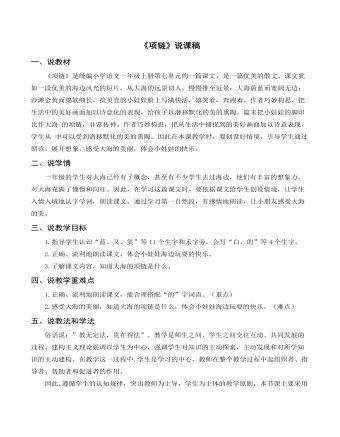
部编人教版一年级上册《项链》说课稿
四、说教学重难点1.正确、流利地朗读课文,能合理搭配“的”字词语。(重点)?2.感受大海的美丽,知道大海的项链是什么,体会小娃娃海边玩耍的快乐。(难点)五、说教法和学法俗话说:”教无定法,贵在得法”。教学是师生之间、学生之间交往互动、共同发展的过程。建构主义理论强调以学生为中心,强调学生对知识的主动探索、主动发现和对所学知识的主动建构。在教学这一过程中,学生是学习的中心,教师在整个教学过程中起组织者、指导者、帮助者和促进者的作用。? 因此,遵循学生的认知规律,突出教师为主导,学生为主体的教学原则,本节课主要采用学案导学、闯关游戏、小组竞赛的方式进行学习。教师主要为学生创设问题情境,引导学生在对话、讨论、交流中觅取新知,启发、点拨学生通过分析人物的心理描把握人物形象、领悟小说主旨。为了提高课堂学习效果,主要利用多媒体课件和学案来进行教学。
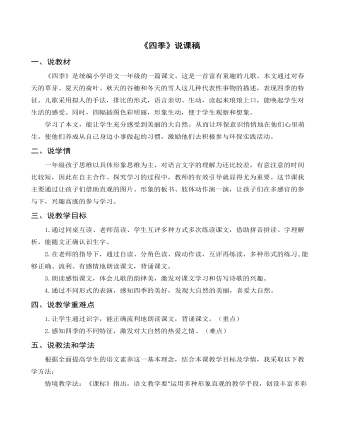
部编人教版一年级上册《四季》说课稿
五、说教法和学法根据全面提高学生的语文素养这一基本理念,结合本课教学目标及学情,我采取以下教学方法:情境教学法:《课标》指出,语文教学要“运用多种形象直观的教学手段,创设丰富多彩的教学情境”。本节课,我通过创设一定情境,激发学生学习兴趣,集中其注意力,拉近学生与文本的距离。以读代讲:本着“以读为本”的教学原则,让学生通过读对课文加深理解,并在图片美的直观感受下读出感情,学生就能进一步的感受感受到语句的优美。叶圣陶先生指出,“教师之为教,不在于全盘授予,而在相机诱导”。学习中突出学生的主体地位,让学生放开手脚,积极参与。本课我指导学生用如下方法进行学习:朗读感悟法:《课标》指出小学各年级的阅读教学都要重视朗读。要让学生充分的读,在读中整体感知,在读中有所感悟,在读中培养语感,在读中受到情感的熏陶。本节课,我让学生通过多种形式的读来感受文中蕴涵的情感。自主合作学习方法:合作学习,培养学生合作意识和自主学习能力。

部编人教版一年级上册《影子》说课稿
【说学法】1.合作学习法。以学生为本、小组合作、生生互助的形式来学习,培养学生在合作中取长补短,互帮互助的合作精神。 同组一起把生字读两遍。然后互相检查看看是否读准字音。并说说自已是怎样记住哪个字的,让学生感受合作学习的快乐。 2.朗读比赛法。为了达到正确、流利地朗读课文的目的。让学生利用多种形式读。如:同桌对读,个别读,小组读等方法,贯穿始终,读中悟,悟中读,收到以读代讲以读悟情的效果。 3.自主评价法。通过让学生自主评价,培养学生倾听,欣赏以及表达能力。从而使低年级学生从小养成学习语文的良好习惯。 五、说教学过程(一)谜语导入,揭示课题1.出示谜语,引出“影子”。? 你有我有他也有,黑身黑腿黑黑头。灯前月下跟你走,就是从来不开口。? (设计意图:猜谜语是小学生喜欢的活动。这个谜语不仅引出了课题,而且呈现了本课要学习的生字,可以给学生一个初步的认识。)
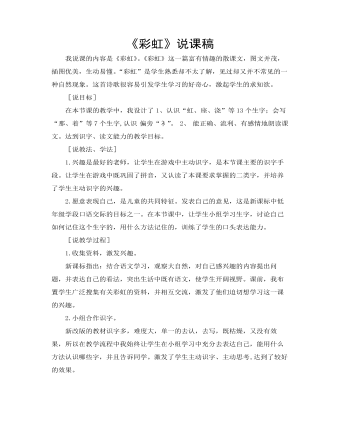
部编人教版一年级下册《彩虹》说课稿
我说课的内容是《彩虹》。《彩虹》这一篇富有情趣的散课文,图文并茂,插图优美,生动易懂。“彩虹”是学生熟悉却不太了解,见过却又并不常见的一种自然现象。这首诗歌很容易引发学生学习的好奇心,激起学生的求知欲。[说目标]在本节课的教学中,我设计了1、认识“虹、座、浇”等13个生字;会写“那、着”等7个生字,认识 偏旁“衤”。 2、 能正确、流利、有感情地朗读课文。达到识字、读文能力的教学目标。
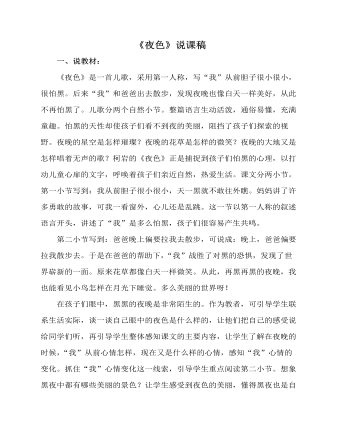
部编人教版一年级下册《夜色》说课稿
一、说教材:《夜色》是一首儿歌,采用第一人称,写“我”从前胆子很小很小,很怕黑。后来“我”和爸爸出去散步,发现夜晚也像白天一样美好,从此不再怕黑了。儿歌分两个自然小节。整篇语言生动活泼,通俗易懂,充满童趣。怕黑的天性却使孩子们看不到夜的美丽,阻挡了孩子们探索的视野。夜晚的星空是怎样璀璨?夜晚的花草是怎样的微笑?夜晚的大地又是怎样唱着无声的歌?柯岩的《夜色》正是捕捉到孩子们怕黑的心理,以打动儿童心扉的文字,呼唤着孩子们亲近自然,热爱生活。课文分两小节。第一小节写到:我从前胆子很小很小,天一黑就不敢往外瞧。妈妈讲了许多勇敢的故事,可我一看窗外,心儿还是乱跳。这一节以第一人称的叙述语言开头,讲述了“我”是多么怕黑,孩子们很容易产生共鸣。
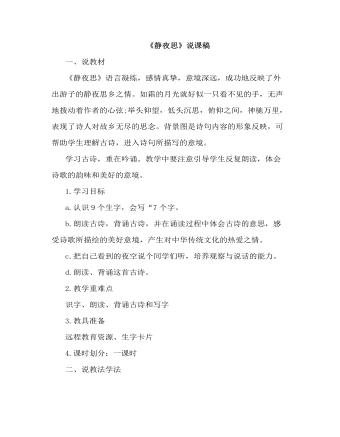
部编人教版一年级下册《静夜思》(说课稿)
为了使学生能在视、听、说、思等几个环节中经历学习的过程,体验学习语文的乐趣,顺利达成教学目标,我设计的教学过程如下:1.观察交流、激发兴趣、情景导入为了能让学生更好的体会静夜,我设计了这一环节。在上新课前一晚,布置学生去观察夜晚的天空,然后上课时把自己观察到夜空的内容和感受,说给同学听,大家互相交流下。交流后引入新课:静夜思。课题引入后,给学生解释下课题,让学生思考一下,诗人是在什么时候思念,又思念些什么?提问后,把远程教育碟片切到《静夜思》这课,让学生欣赏课文。2.初读古诗,整体感知,认读生字我设计这一环节,是想让学生通过自己朗读课文,去发现这课的生字,并在这环节中,要求学生利用拼音帮助自己读准每个字,尤其是一些后鼻音,让学生成为学习的主人。

部编人教版四年级下册《琥珀》说课稿
二、说理念:1.在教学中,尊重学生的个性化行为,引导学生在积极主动的思维和情感活动中,自主体验、感悟,注重体验过程。2.课外延伸,发挥学生的创造潜能,激活学生的想象能力,使课内学习与课外发展相得益彰,提高学生的语文素养。三、说目标:1.理解课文内容,根据琥珀的样子推想它的形成过程,体会科学家是怎样进行合理想象的。这也是本文的教学重难点。2.发展学生的合作、探究精神,根据其它的化石推想成因,学习有依据地、合理地进行想象,培养学生的想象能力。3.通过学习,激发学生探索大自然奥秘的兴趣,树立热爱科学的情感。四、说教与学活动步骤:(一)整体把握课文,进入语文实践教师出示文中“琥珀”的图片,学生围绕这块琥珀,说一说课文都写了哪些内容。随着学生的汇报,抓住琥珀的样子与它的价值这一段落,学生进行朗读,发现“想象”和“推测”两个词语,并理解意思。随之和科学家一起合理想象琥珀形成的过程。
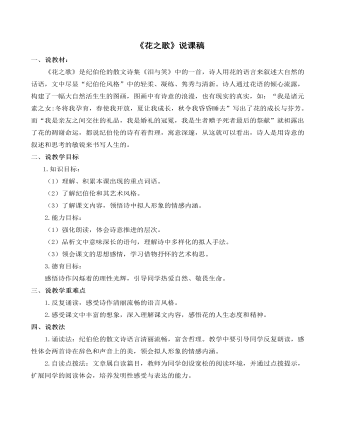
部编人教版六年级上册《花之歌》说课稿
一、说教材: 《花之歌》是纪伯伦的散文诗集《泪与笑》中的一首,诗人用花的语言来叙述大自然的话语,文中尽显“纪伯伦风格”中的轻柔、凝练、隽秀与清新。诗人通过花语的倾心流露,构建了一幅大自然活生生的图画,图画中有诗意的浪漫,也有现实的真实,如:“我是诸元素之女:冬将我孕育,春使我开放,夏让我成长,秋令我昏昏睡去”写出了花的成长与芬芳。而“我是亲友之间交往的礼品,我是婚礼的冠冕,我是生者赠予死者最后的祭献”就袒露出了花的凋谢命运,都说纪伯伦的诗有着哲理,寓意深邃,从这就可以看出,诗人是用诗意的叙述和思考的敏锐来书写人生的。 二、说教学目标 1.知识目标: (1)理解、积累本课出现的重点词语。 (2)了解纪伯伦和其艺术风格。 (3)了解课文内容,领悟诗中拟人形象的情感内涵。
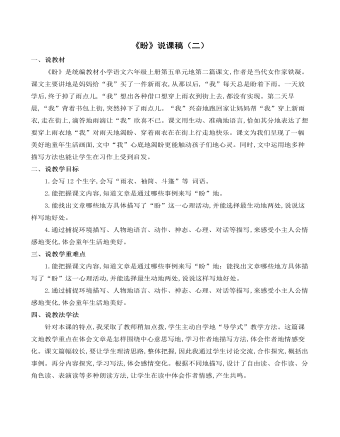
部编人教版六年级上册《盼》说课稿(二)
一、说教材 《盼》是统编教材小学语文六年级上册第五单元地第二篇课文,作者是当代女作家铁凝。课文主要讲地是妈妈给“我”买了一件新雨衣,从那以后,“我”每天总是盼着下雨。一天放学后,终于掉了雨点儿,“我”想出各种借口想穿上雨衣到街上去,都没有实现。第二天早晨,“我”背着书包上街,突然掉下了雨点儿。“我”兴奋地跑回家让妈妈帮“我”穿上新雨衣,走在街上,滴答地雨滴让“我”欣喜不已。课文用生动、准确地语言,恰如其分地表达了想要穿上雨衣地“我”对雨天地渴盼、穿着雨衣在在街上行走地快乐。课文为我们呈现了一幅美好地童年生活画面,文中“我”心底地渴盼更能触动孩子们地心灵。同时,文中运用地多种描写方法也能让学生在习作上受到启发。 二、说教学目标 1.会写12个生字,会写“雨衣、袖筒、斗篷”等 词语。 2.能把握课文内容,知道文章是通过哪些事例来写“盼”地。

部编人教版六年级上册《盼》说课稿(一)
【教材分析】《盼》是六年级第五单元的一篇课文。本文选自作家铁凝的第一本出版小说《夜路》,是一篇儿童文学类的小说。作者以孩子的视角,记述了得到新雨衣,渴望下雨到愿望实现——在雨中穿上了新雨衣的故事。用细腻的语言描述了小主人公情感和心理的变化,表现了童真童趣。【教学目标】1.疏通重难点字词的读音和写法。2.整体感知课文内容,把握故事情节,理清行文思路,感受小主人公因新雨衣而产生的“盼”。3.通过捕捉环境描写、人物的语言、动作、神态、对话等描写,来感受小主人公情感的变化。【教学重难点】通过捕捉环境描写、人物的语言、动作、神态、对话等描写,来感受小主人公情感的变化。【教学过程】核心问题:作者如何围绕一个“盼”字展开描写,表现小主人公的情感变化?

人教版高中英语必修4Body Language说课稿4篇
Textbook: Senior English for China (Book 4), by Liu Daoyi Time Allotment: 1 period (40 minutes)Date: March 20, 2014Teaching aids: blackboard, Multi-media, Power Point, chalk I. Text Analysis (教材分析)This unit is about body language, and the text selected in the reading part demonstrates the difference and similarity of body language in many parts of the world. Through learning this passage, students are required to raise their awareness of using body language in different parts of the world. As body language is closely related to our daily life, it is easy to arouse students’ interest in learning this text. Reading skills and speaking training are designed around the text.II. Teaching Objectives (教学目标)By the end of the lesson, students will be able to:1. Language Skill Objective(语言技能目标): develop reading ability (skimming and scanning)as well as speaking ability.2. Cultural Knowledge Objective(文化知识目标): know about the cultural differences of using body language.3. Affective Objective(情感目标): increase students’ awareness of using body language correctly in different cultures. III.Teaching Focuses and Difficulties(教学重点和难点)1. Teaching Focuses(教学重点): the difference and similarity of body language in many parts of the world.2. Teaching Difficulties(教学难点): develop students’ reading abilities of skimming and scanning and ask the students to show their opinions with fluent English.

人教版高中英语必修1Nelson Mandela--A Modern Hero说课稿
In this step, give students a few minutes to read the passage . While they are reading, I will write some key words of the text on the blackboard. Then ask students to retell the passage according to the key words.By retelling, students can improve their ability of language organization and have an overall understanding of the article.Step 4 Group discussionIn this step, students will be divided into groups of 4 to discussion the following question: What qualities make a great person?After their discussion, invite a few groups to make a report to the class.This group discussion can practice students’ oral English and cultivate their abilities of cooperation and communication.Step 5. HomeworkLet students write a short passage to introduce a great person he or she admires.The homework can consolidate the knowledge the students have learned and cultivate their writing ability. Part 6 Blackboard Design(板书设计)That’s all my teaching procedures. Finally, I’d like to say sth about part 6 blackboard design. On the top is the title. On the left, there will be some new words and expressions. In the middle of the blackboard, I will write some useful sentence structures so that the students can know clearly what they’ve learned and then try to master the knowledge.OK. That’s all for my presentation. Thank you for your attention.

人教版高中英语必修2Cultural Relics说课稿2篇
Ⅲ. Analysis of the teaching material:The topic of this unit is cultural relics. Students are quite interested in topics about different cultures around the world. This is the second period of the whole unit. As a reading class, the passage mainly talks about the history of the amber room (how it was made, sent as a gift, lost and rebuilt).According to the new national curriculum, when teaching reading, much emphasis should be put on training the students’ reading skills.Ⅳ. Teaching objectives1. Language objectives:1) Students are required to master the key words and phrases occurred in the passage (e.g. amazing, decorate, belong, in return, less than etc.)2) Students are required to learn the attributive clause and acquire the sentence pattern.2. 1) Students are required to describe a certain thing by using the new sentence patterns.2) Students are required to master two kinds of reading skills—skimming and scanning, and learn to use them in their daily reading.3. 1) Students are required to know the history of the amber room.2) Students are required to appreciate cultural relics and understand the importance of protecting them.Ⅴ. Teaching important and difficult points1) the new words, phrases, and sentence pattern in the course of reading.2) Teaching difficult point: Help the students master two kinds of reading skills—skimmingand scanning and learn to apply them in daily use.Ⅵ. Teaching methods:Task-based method & Top-down model Ⅶ. Teaching aids: PPT, pictures, blackboard Ⅷ. Teaching procedure:

人教版高中英语必修4Women of achievement说课稿4篇
Good morning, distinguished judges:It’s my honor to talk about my teaching ideas with you. Today my topic is Women of Achievement. My presentation consists of six parts: the analysis of teaching material and student, teaching aims, key and difficult points, teaching and studying method, teaching procedures and blackboard design.First, let’s focus on the analysis of teaching material. This lesson is from New Senior English for China Student’s Book 4 Unit 1, the reading part. The main topic of the passage is the introduction of a student of Africanwildlife. After this lesson, the students will learn more information about her studying chimps in Africa, and their reading and speaking abilities can be developed as well.The next part is the analysis of students. My students are in senior high students. They have learnt English for many years, they’ve known many words and sentences, but their speaking and reading abilities are still not very good. So I will practice their speaking and reading abilities through different exercises.According to the New Standard Curriculum and the present situation, I set the teaching aims as follows: firstly, knowledge aims. Students can grasp some new words, such as worthwhile, move off. Moreover, students can understand the content of the passage and get familiar with the topic of studying chimps in wildlife. Secondly, ability aims. Students can use reading strategies such as skimming and scanning in reading process. Thirdly, emotional aims. Students can have the awareness of protecting animals and care about animals.Based on the above analysis, the key point of this lesson is to get the main idea and the detailed information from the passage; the difficult point is to talk about the wildlife protection and use reading strategies.

人教版高中英语必修1Anne's best friend说课稿
Step 7 Language points 1.Vocabulary (1) go through (2) set down (3) a series of (4) on purpose (5) in order to (6)at dusk (7)entirely (8)face to face 2.Important sentences (1)…I’ve grown so crazy about everything to do with nature. (2)There was a time when … (3)I stayed awake on purpose until … (4)It was the first time … that I’d seen the night … (5)It’s no pleasure looking through … Purpose: 1.Master the required vocabulary and sentence structures. 2.Use them freely. Step 8 Consolidation 1.Find out the topic sentences 2.Retell the text according to the topic sentences Purpose: I want to know if my students understand the text. Step 9 Discussion Imagine you have to go into hiding like Anne and her family, what would you miss most? Giveyour reasons. Purpose: Train Ss’ oral English ability. Step 10 Homework Write an article on Friends. Purpose: 1. Improve the Ss’ writing ability. 2 Train the Ss’ ability of self—teaching and looking up information by themselves. Part 5 Blackboard design(说板书设计)Unit 1 Friendship Reading Anne’s Best Friend 1.Main idea of each paragraph: Para. 1 Anne made her diary her best friend. Para .2 Anne wrote her feelings in her diary. Para .3 Anne missed nature. Para.4 Anne saw the night face to face Para.5 Anne wanted to experience nature outdoors. 2.Listening: Exx.1 P3 3.Discussion: Exx.3 P3 Purpose: 1.Make Ss familiar with the passage 2.Make the design inductive, instructive and artistic.

人教版高中英语必修5First aid说课稿6篇
In this class, I have 3 teaching aims, that is, knowledge aims, ability aims and emotion aims.1) Knowledge-Teach students new words and expressions, such as temporary, bleed,sprain choke, first aid, fall ill and so on.-Enable students to have a better understanding for some basic knowledge of first aid.2) Ability-Train students’ speaking, reading and writing abilities by different teaching activities, such as skimming, comprehending, team work, role play, retelling and writing.-Develop students’ reading strategy on how to move general idea to specific information.3) Emotion-Promote students’ awareness of giving first aid.- Cultivate students’ creativities.Then let’s come to my teaching methods and activities.III. Teaching methods and activities:To achieve different teaching aims, various kinds of teaching methods and activities will be adopted throughout this period, such as TBL (task-based learning), skimming, team work, brainstorm and others, which can offer students opportunities to fulfill tasks in which they can use language to achieve a specific outcome.IV. Teaching aids:Computer and blackboardV. Teaching important points:1) Make students have a clear mind for the structure of the text.2) Help students understand the theme of the text.VI. Teaching difficulties:1) So many new words may affect students’ understanding.2) How to get students to know about the functions of the skin and thecauses, characteristics and treatments for different degree burns,and the knowledge about giving first aid. VII. Blackboard design:

人教版高中英语必修5Great scientists说课稿4篇
通过写文章梗概,培养学生综合运用语言的能力,学习用恰当的英语描述科学家的故事。这是本课的教学难点。教师可以使用完形填空的方式来帮助学生整理语篇,从而来降低难度。本课的教学重点的突破方法是:在阅读前,让学生初步了解得出科学观点所需要的基本程序,从而轻松而自然地导入文章的阅读;在阅读过程中,由易到难设计快速阅读和精读的问题,层层推进各种阅读活动,让学生对阅读内容从整体感知到细节理解,最后深层读懂整篇文章,同时加强阅读策略的指导,让每个学生都主动参与课堂教学活动,最终达到提高阅读能力的目的。Step 4 Post-readingGroup Activities四人小组共同合作,在老师的适当指导下,就以下2个问题展开讨论,让学生就所知、所学、所感和所想融入话题,然后抽若干同学代表作小组发言。1. What do you think about John Snow, and what should we learn from him?2. Cholera was 19th century disease, which two diseases are similar to cholera today? Why?
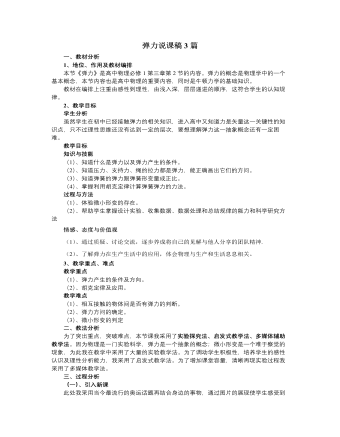
人教版新课标高中物理必修1弹力说课稿3篇
基于以上分析,为使本堂课围绕重点、突破难点,同时让学生在课堂教学中能力得到提高,我设计如下教学过程。(一)创设情景认识形变由同学们已有的形变知识入手,引入新课。教师演示:①弹簧的压缩形变;②弹簧的拉伸形变③视频播放:竹竿形变、钢丝的扭转形变。得出形变的概念及各类形变。[设计意图:我从生活情景中引入新课,是为了激发学生的好奇心,为学生学习重点和难点内容作铺垫。]设问:摩天大楼在风的吹拂下会不会摆动,发生形变吗?演示微小形变放大实验:由于这种形变不容易观察,会使学生产生疑问:到底有没有发生形变?解决的办法是微小形变的演示实验。为什么光点会往下移?让学生带着问题思考后得出结论:是由于桌面发生了形变,但是形变不明显。为后面解决压力和支持力都是弹力做好铺垫。[设计意图:使学生知道“放大”是一种科学探究的方法。]
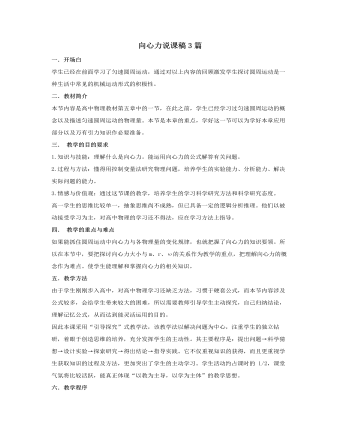
人教版新课标高中物理必修2向心力说课稿3篇
通过这个示例呢,我们可以得到解决向心力问题的一般的步骤,确定对象,找出轨迹,找出圆心,然后进行受力分析,让同学们参考这样的步骤,逐步的解决圆周运动的问题,对于变速圆周运动,我通过链球运动进行引入,这里是一个链球运动的视频,在同学们观看视频之前,我给同学们提出问题,链球收到绳子的拉力,做的是匀速圆周运动吗? 然后再课堂上我们再做一个小实验, 我们可以通过改变拉线的方式来调节小球的速度大小吗? 那么对小球,做加速圆周运动,进行受力分析,我们可以看到,小球做加速运动时,他所受到的力,并不是严格通过轨迹的圆心,在进行分析的时候,特别强调,小桶所受力的切线方向分力,和法线方向分力,切线方向分力,改变小球运动速度大小,法线方向分力,改变了小球运动的方向,法线方向的分力,在这里就是向心力,产生了向心加速度,通过这样一个例子进行分析,同学们是比较容易理解的,

小学美术人教版六年级下册《第9课图文并茂3》教学设计说课稿
2重点难点教学重点第一课时:了解绘画故事的表现特点,感受真、善、美。第二课时:绘画自编故事的创作特点及步骤。教学难点第一课时:选材、构思设计。第二课时:构图与绘制3教学过程3.1 第一课时教学活动活动1【导入】“连连看” 教师提供数张图片和几句话(或几段文字),请学生根据文字找到相应的图画将它们连起来,并找出先后顺序将故事讲完整。教师小结,出示课题《图文并茂》。设计意图:以游戏的形式“连一连”,激发学生的好奇心和兴趣,以饱满的热情投入学习内容——图文并茂。